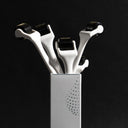Is minoxidil not working for your hair loss?
In this guide, we'll explore alternative treatments and combinations that may enhance your results and promote fuller hair growth.
Discover effective strategies to achieve the thick, healthy hair you desire.
Table of content
Why isn't minoxidil working?

Several factors could explain why minoxidil isn't working as expected:
Insufficient time
Minoxidil typically takes 3-6 months to show noticeable results. Consistent use over an extended period is crucial for optimal results.
Incorrect application
Not following the recommended dosage and application guidelines may reduce minoxidil's effectiveness.
Underlying health conditions
Conditions like hormonal imbalances or nutrient deficiencies may contribute to hair loss and reduce the effectiveness of minoxidil.
Severity of hair loss
Minoxidil is more effective in the early stages of hair loss. If hair loss is advanced, minoxidil may not provide significant improvement. e. Individual response: Minoxidil does not work for everyone. Some individuals may not respond to minoxidil treatment.
If minoxidil isn't producing the desired results, consult a healthcare professional to discuss alternative treatments and potential underlying causes.
As your leading source for hair health information over the past 4 years, we never compromise on accuracy. When it comes to your health, you deserve information you can truly rely on - and earning your trust is our top priority.
Here's how Scandinavian Biolabs ensures every piece of content meets the highest standards of accuracy and integrity:
- Credentialed Experts: Our reviewers are actively practicing doctors and medical researchers
- Stringent Reviews: Content undergoes rigorous editing by subject specialists and review by a practicing doctor.
- Evidence-Based: We rely on well-established research from trusted scientific sources like peer-reviewed journals and health authorities.
- Full Transparency: Our editorial standards, writer credentials, reviewer credentials, correction process, and funding are all publicly documented.
- Independent Voice: While we do promote products, we operate in a vacuum to business operations. Our main goal is just an unwavering commitment to providing medically-sound guidance.
You can count on Scandinavian Biolabs to consistently deliver the trustworthy health information you deserve. Read our Editorial Standards.
What should you do when minoxidil's not working?
If minoxidil isn't effective for you, consider exploring alternative treatments such as finasteride, or using both minoxidil and finasteride together for enhanced results and thicker hair regrowth.
Here are few more suggestions for you from the diary of a dermatologist:
Be patient
Minoxidil is essential to any hair loss prevention regimen, but it can take time to see results.
For some people, it may take some months of consistent use before they start to see a reduction in hair loss.
Therefore, it is mandatory to be patient and continue applying the product correctly. The instructions on the label should be followed, either applying minoxidil once a day or twice a day.
If you stop using minoxidil, any progress you have made will be reversed.
Try a different treatment
If you have been using minoxidil for several months with no results, it may be time to try a different treatment.
We've been working on a comprehensive but concise guide to the best alternatives to minoxidil that will provide amazing hair regrowth!
Read the most effective alternatives to minoxidil!

Consult a healthcare professional
If you do not see results from minoxidil, it may be time to consult a healthcare professional. After all, they are the experts.
They will likely ask you questions about your medical history and family history. They will also want to know about your diet, stress levels, and exercise routine.
Once they have all the information, they can determine if minoxidil is the proper treatment for you. If it's not, they will likely recommend another course of treatment i.e. finasteride, nanoxidil, hair growth products or hair transplant.
So, if you do not see results from minoxidil, don't hesitate to consult a healthcare professional.

Combine minoxidil with finasteride
If you're like most people, you probably start to panic when you realize that your hair loss treatment isn't working as well as you'd hoped.
But instead of reaching for the nearest bottle of Rogaine, take a deep breath and consider trying a combination therapy of minoxidil and finasteride.
Minoxidil is a vasodilator that helps to promote blood flow and hair growth.
At the same time, finasteride is a 5-alpha reductase inhibitor that slows the rate of hair loss.
Together, these two medications can provide effective hair loss prevention for men.
So if your current treatment isn't giving you the desired results, don't give up hope just yet - try minoxidil and finasteride combo instead.
Better yet, use minoxidil with a dermaroller, it will help open up your scalp pores, allowing minoxidil to penetrate easier!
What is minoxidil?

Minoxidil was initially developed for the treatment of recalcitrant hypertension, in the form of an oral formulation. The investigators observed an increased hair growth, in the form of hypertrichosis.
The observation of increased hair growth led to the development of topical minoxidil formulation for the treatment of various forms of hair loss such as androgenetic alopecia, traction alopecia, and alopecia areata. There are two topical formulations of minoxidil, minoxidil solution and minoxidil foam.
Minoxidil foam has several benefits as compared to the minoxidil solution:
- It dries more quickly
- It does not contain propylene glycol (a compound responsible for causing irritation of the scalp)
- It absorbs more readily
- The active ingredients have greater penetration in the scalp
The topical formulations are available in 2% and 5% concentrations.
How does minoxidil work?
Get ready for some super sciency stuff! Or, scroll down to the solutions!
There are several mechanisms proposed by the investigators to explain the working of minoxidil and its effects on the hair growth cycle and the hair follicles.
One of the hypotheses describes that minoxidil causes the opening of potassium channels in the arterial smooth muscle, resulting in vasodilation and increased blood flow.
The topical formulation of minoxidil delivers this medication to the arteries found in the scalp. The vasodilation of these blood vessels increases the blood flow towards the growing hair follicles.
This not only provides the growing hair follicles with the necessary nutrients but also drains away harmful metabolites.
By acting on the potassium channels, minoxidil also promotes DNA synthesis in the cells of the hair follicles and promotes cell proliferation in the early stages of the cell cycle.
The action of minoxidil on the hair follicle is associated with its active metabolite, minoxidil sulfate. The formation of minoxidil sulfate is catalyzed by the enzyme known as sulfotransferase.

What are the side effects of minoxidil?
Minoxidil is generally a safe and effective topical formulation for the treatment of hair loss in both male and female populations.
The common side effects of minoxidil may include headache, dizziness, and shedding of hair in clumps. These side effects are usually temporary and tend to subside with the cessation of minoxidil treatment.
Minoxidil may also cause temporary shedding of hair, which is in the telogen phase of the hair growth cycle. This subsides after a few weeks of treatment initiation.
More severe side effects of minoxidil may include sexual dysfunction, mental health deterioration, rapid heartbeat, fainting heartbeat, and chest pain.
In case of the occurrence of these side effects, you shall discontinue minoxidil and consult a medical professional at your earliest.
You can also consult your doctor before starting the treatment in order to avoid potential drug interactions or adverse events.

Conclusion
Minoxidil is a safe and effective treatment of hair loss associated with different conditions. This medication was initially developed as an oral formulation for the treatment of hypertension and was later approved for hair loss treatment. Minoxidil may have different side effects including scalp irritation.
While it is effective for hair loss and restoration of hair growth, minoxidil may not work for everyone. The health of the scalp, age of individuals with hair loss, and genetic predisposition are among the several factors that influence the action of minoxidil on the hair follicles for the suppression of hair loss and improvement in the hair growth.
For individuals who fail to derive benefits from minoxidil for hair loss treatment, they shall remain patient, combine minoxidil with finasteride, consult a healthcare professional, and/or try a different treatment.
Reference
Gupta AK;Charrette A. (2015). Topical Minoxidil: Systematic Review and Meta-Analysis of Its Efficacy in Androgenetic Alopecia. Skinmed, 13(3). https://pubmed.ncbi.nlm.nih.gov/26380504/
Gupta, A. K., Talukder, M., Venkataraman, M., & Bamimore, M. A. (2021). Minoxidil: a comprehensive review. Journal of Dermatological Treatment, 33(4), 1896–1906. https://doi.org/10.1080/09546634.2021.1945527
Read more:





